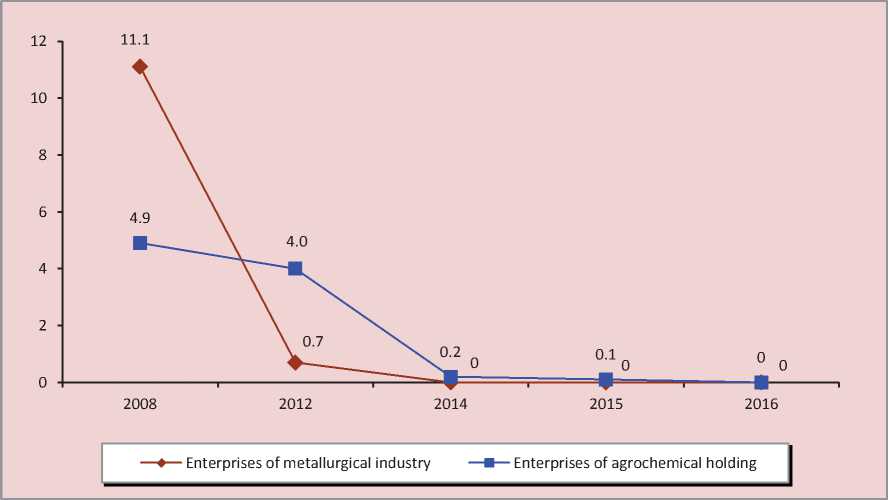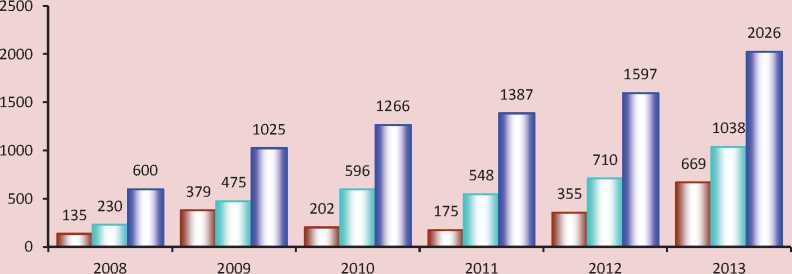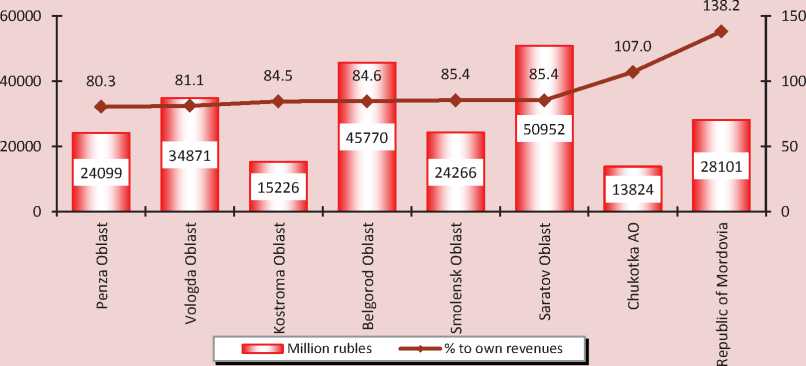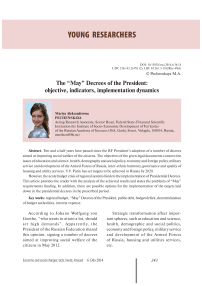The “May” decrees of the president: objective, indicators, implementation dynamics
Автор: Pechenskaya Mariya Aleksandrovna
Журнал: Economic and Social Changes: Facts, Trends, Forecast @volnc-esc-en
Рубрика: Young researchers
Статья в выпуске: 6 (36) т.7, 2014 года.
Бесплатный доступ
Two and a half years have passed since the RF President’s adoption of a number of decrees aimed at improving social welfare of the citizens. The objectives of the given legal documents concern the issues of education and science, health, demography and social policy, economy and foreign policy, military service and development of the Armed Forces of Russia, inter-ethnic harmony, governance and quality of housing and utility services. V.V. Putin has set targets to be achieved in Russia by 2020. However, the acute budget crisis of regional systems hinders the implementation of Presidential Decrees.This article provides the reader with the analysis of the achieved results and states the problems of “May” requirements funding. In addition, there are possible options for the implementation of the targets laid down in the presidential decrees in the prescribed period.
Regional budget, "may" decrees of the president, public debt, budget deficit, decentralization of budget authorities, interest expense
Короткий адрес: https://sciup.org/147223674
IDR: 147223674 | УДК: 336.143.2(470.12) | DOI: 10.15838/esc/2014.6.36.18
Текст научной статьи The “May” decrees of the president: objective, indicators, implementation dynamics
According to Johann Wolfgang von Goethe, “who wants to attain a lot, should set high demands”. Apparently, the President of the Russian Federation shared this opinion, signing a number of decrees aimed at improving social welfare of the citizens in May 2012.
Strategic transformation affect important spheres, such as education and science, health, demographic and social politics, economy and foreign policy, military service and development of the Armed Forces of Russia, housing and utilities services, etc.
Two years have already passed since the President signed the “May” Decrees.
The results of the two year work
Let us refer to the official statistics disclosed by the RF Government. For two years out of 218 President’s Decrees one hundred and twenty-one have been executed, resulting in the adoption of 69 federal laws, 200 legal acts of the Government, 150 programs, strategies and other measures. In 2014 twenty-five decrees are to be implemented, 13 in 2015 and 39 in 2016–2020. More than 22% of the total number of decrees pertains to the competence of the Ministry of Economic Development [1, 3, 8]. However, the regional authorities have experienced the main burden. It is they who have felt the financial burden of improving the lives of the Russians and enhancing the efficiency of the Russian economy.
So, the Vologda Oblast Government in 2013 allocated of 4.4 billion rubles for the implementation of the President’s Decrees. These funds together with federal helped achieve the following [9]:
– the target level of wages of teachers, social workers and employees in the sphere of culture has been achieved;
– 2658 places for children in kindergartens have been created;
– 821 families have been relocated from dilapidated housing, which living space amounted to 31.1 thousand square meters;
– 7 multi-service centers have been opened and the share of citizens who have access to public and municipal services by the principle of “one window” has increased by 34%;
– monthly payment to low-income families for the third and subsequent children amounting to 6398 rubles and totaling of 57.5 million rubles has been paid.
These targets implementation is carried out in accordance with the terms specified by the President of Russia. However, not all targets have been achieved in time. Wages of health workers, kindergarten teachers and teachers of schools, colleges and vocational schools have increased to a lesser degree than required by the program of gradual improvement of the remuneration system.
The higher authorities have signed the decrees the local governments should implement.
The Vologda Oblast budget requires 35.9 billion rubles to execute the President’ Decrees in 2014–2016 [5]. However, the sources are unclear, as the growth of own revenues in the region is to be 7.3 billion rubles. Thus, using only own resources the region can finance only 55% of the demand for the Presidential Decrees implementation (tab. 1).
It will be difficult to increase this percentage – the budgetary situation in the region is complicated and characterized by the negative dynamics of key fiscal indicators.
Table 1. Volume and structure of budgetary allocations for the implementation of the Presidential Decrees in the Vologda Oblast in 2014–2016, million rubles
|
Decree |
2013 Requirement |
2014 |
2015 |
2016 |
||||
|
Provided |
Requirement |
Provided |
Requirement |
Provided |
Requirement |
|||
|
On the long-term state economic policy |
4.9 |
4.1 |
4.1 |
4.2 |
4.2 |
4.4 |
4.4 |
|
|
On the measures to realize the state social policy |
2587.6 |
4910.1 |
4171.8 |
6449.3 |
5473.7 |
8 760.3 |
7 347.1 |
|
|
On the improvement of the state policy in the sphere of health |
18.9 |
17.1 |
17.1 |
23.7 |
23.7 |
25.3 |
25.3 |
|
|
On the measures to realize the state policy in the field of education and science |
985.8 |
1423.2 |
0.0 |
1 333.2 |
46.5 |
1 429.3 |
44.3 |
|
|
On the measures to provide Russian citizens with affordable and comfortable housing and improve the quality of housing and public utility services |
1030.7 |
1 923.4 |
967.2 |
3 498.1 |
403.0 |
1 605.4 |
100.0 |
|
|
On the main directions to improve the system of public administration |
182.9 |
747.7 |
69.3 |
428.2 |
27.1 |
229.4 |
27.0 |
|
|
On the measures to implement the demographic policy of the Russian Federation |
34.1 |
83.7 |
83.7 |
119.4 |
119.4 |
180.2 |
180.2 |
|
|
On the national strategy for action for children |
1.6 |
517.3 |
5.4 |
673.4 |
7.7 |
861.9 |
10.6 |
|
|
On some measures to implement the demographic policy in the sphere of protection of children-orphans and children left without parental care |
12.4 |
177.3 |
112.1 |
211.6 |
177.3 |
252.7 |
248.0 |
|
|
Total |
4859.0 |
9803.9 |
5430.6 |
12741.2 |
6282.8 |
13348.8 |
7986.9 |
|
|
Lack of funds |
% |
55.4 |
49.3 |
59.8 |
||||
|
Million rubles |
-4373.3 |
-6458.4 |
-5361.9 |
|||||
Source: Annex to the Explanatory note to the draft Law “On the regional budget for 2014 and the planned period of 2015 and 2016”.
First, own revenues continue to fall due to the shortfall of income tax.
In 2014–2016 the forecasted values of total and own revenues in current prices will exceed the pre-crisis level, although in 2014 own revenues will be below the 2008 level by 0.9 billion rubles. However, the reassessment of amounts of own revenues in real terms, i.e. adjusting in terms of the consumer price index, reveals that it is impossible to reach the pre-crisis level: 40.8 billion rubles in 2016 against 55.9 billion rubles in 2008 [10, p. 148] (fig. 1).
This trend has become nationwide. For example, in the Vologda Oblast the situation is catastrophic: tax revenues decreased by 46% in 2013 compared with 2012 (by 13% in Russia).
The revenue of the largest regional enterprise PАО Severstal is to be zero in the next three years and the revenues of two large taxpayers – OJSC PhosAgro-Cherepovets and JSC Agro-Cherepovets – will have reduced to 0.2 billion rubles by 2016 (fig. 2).
Figure 1. Tax and non-tax revenues of the regional budget in real terms, in 2016 prices, billion rubles [10]

Figure 2. Receipts from profit tax in the consolidated budget of the Vologda Oblast, billion rubles

Source: compiled by [6].
At the same time, own revenues w/o profit tax, in contrast, have increased by 13%. No wonder, economists consider profit tax as “tax on the verge”. It depends on market conditions, which weakness, rising costs on the market of budget revenue generating metallurgical industry and introduction of the system of consolidated groups of taxpayers have caused a fall in tax revenues in the region.
Second, the debt load of the Vologda Oblast budget in 2013 exceeded own revenues by 6.3%.
In the coming three years a third of the budget will be allocated to repay loans and deficit of the regional budget system (tab. 2).
This trend is typical for the vast majority of Russian regions. The need to finance the presidential election programs, despite the reduction in revenues, has provoked an unprecedented increase in the deficit of regional budget systems. In 2013 it amounted to 670 billion rubles, or 11.6% of budgets’ own revenues. Let us note that 77 out of 83 regions had a negative result of the budget execution. In turn, the debt load of the RF subjects increased by 4.5 times, debt load – by 3.4 times (fig. 3).
The regions’ public debt accounted to almost a third of own budget revenues. In some RF subjects debt exceeded 80 and even 100% of tax and non-tax revenues (fig. 4).
In the RF subjects in 2013 the costs growth rates exceeded budget revenue growth rates (6% against 1%). At the same time, federal financial assistance has decreased by 7%. The RF Accounts Chamber1 has singled out the risk to miss deadlines of some targets among other problems of budget execution in the opinion on the draft federal budget 2014–2016 [7]. Therefore, the severe financial situation in most subjects requires flexible execution of the President’s “May” Decrees.
Table 2. Impact of public debt on the Vologda Oblast budget
|
Indicator |
2009 |
2010 |
2011 |
2012 |
2013 |
|
Expenditure on repayment of loans , million rubles |
509.4 |
1336.7 |
4120.4 |
5735.8 |
7043.9 |
|
Interest expense , million rubles |
161.1 |
488.8 |
789.1 |
1322.1 |
1769.0 |
|
Total , million rubles |
670.5 |
1825.5 |
4909.5 |
7057.9 |
8812.9 |
|
Share in the expenses of the regional budget, % |
1.8 |
4.2 |
10.6 |
15.6 |
19.9 |
|
Actual deficit of the regional budget, million rubles |
6487.7 |
7048.9 |
7177 |
2814.8 |
3952.9 |
|
In % to own revenues of the regional budget |
34.1 |
27.3 |
25.0 |
8.9 |
13.1 |
|
Real deficit* of the regional budget, million rubles |
6997.1 |
8385.6 |
11297.4 |
8550.6 |
10996.8 |
|
In % to own revenues of the regional budget |
36.8 |
32.4 |
39.3 |
27.1 |
36.3 |
|
* Taking into account the expenditure on repayment of loans, which in accordance with the Budget Code are not included in the cost structure of the RF subject budget. Sources: calculated by the author by the accounting records of the Treasury of Russia; the Ministry of Finance of the Russian Federation. |
|||||
1 The Accounts Chamber of the Russian Federation is known to coordinate and control the “May” Decrees of the RF President. Since 2014 site inspections are planned in addition to monitoring.
Figure 3. Fiscal deficits, public debt and loans of consolidated budgets of the RF subjects, billion rubles

□ Deficit □ Bill payable □ Public debt
Source: calculated according to the statements of the Treasury of Russia, RF Ministry of Finance.
Figure 4. Rating of the RF subjects with the maximum debt load in 2013

Corridor of opportunities...
Various levels of government offer possible options to execute the Presidential Decrees in the prescribed period.
-
1. “Not always what you want you really need” (D. Lama).
-
2. “The most unpleasant piece of news: a government inspector is coming to visit us” (N.V. Gogol).
-
3. “Debt is the beginning of slavery” (V. Hugo).
-
4. “You should limit the power if you want it to become stronger” (L. Bern).
In the Ministry of Finance there are talks about possible “adjustment of a range of public sector employees who need the increase in wages in the framework of the
“May” Decrees. For example, it is possible to clarify the requirements for the category “doctor” or exclude the representatives of law enforcement agencies from the list [4].
The member of the Expert Council at the Institute of Socio-Economic and Political Studies Aleksei Zudin believes that
“the problem to execute the “May” Decrees in the regions is caused by the inability to properly prioritize” [12]. “Most officials simulate work on orders execution and only pretend executing”, adds Dmitry Abzalov, Vice President of the Center for Strategic Communication [12]. By the way, the State Duma of the Russian Federation is developing a bill to increase penalties for failure to fulfill the decrees and orders of the President.
The draft law introduces amendments to the Code of Administrative Offences and the Criminal Code, which involve amenability for non-execution, improper performance and failure to meet time constraints of Presidential decrees. According to one of the authors of the bill – a member of the Committee for Security and AntiCorruption of the State Duma D. Gorovtsov, amenability can include penalty of 100–150 minimum wages, deprivation of class rank, prohibition to engage in public office, deprivation of state awards, military and special ranks. Effective management should be considered as reserve of funds [4].
According to Anton Ishchenko, the member of the RF State Duma, it is necessary to “partially write off subjects’ debt to the federal center or relend regions at the expense of the Reserve Fund and the National Wealth Fund” [13]. According to Deputy Finance Minister Leonid Gordin, at the same time, “the write-off of loans is applied in exceptional cases”. However, the Finance Ministry has not ruled out the possibility of refinancing commercial loans by budget ones.
According to Natalia Zubarevich, Director of the Regional Program of the Independent Institute for Social Policy, “power overconcentration at the federal level has reached the inefficiency limit; it is time to move in the opposite direction”. The policy of fiscal powers decentralization was announced by the then Russian President Dmitry Medvedev at the meeting of the State Council December 26, 2011. The reason of the Government’s protracted work is the following: the centralization advocates argue that the provision of macro-stability and macro-management of the vast territory is possible only through the “top-down” distribution of inter-budgetary relations. However, the federal structure of the Russian Federation is a complex multi-level system, which components (regions and municipalities) are more susceptible to negative influences of the external environment and instability in terms of the centralization. So, the question arises: why are the expenditure commitments on increasing the wages of public sector employees (which is within regions’ competence) sent out without proper and complete financial security?
All these proposals are primarily aimed not at saving current investment opportunities of the Russian territories, but further developing social, transport and utilities infrastructure. The problems of the growing budget deficit, debt and loan charge do not contribute to the release of additional funds; therefore, the regions require federal assistance.
The RF Ministry of Finance considers the country’s budget structure as clumsy due to the irrationality of budgetary expenditures, which should already have been optimized and public spending on the
Table 3. Calculation of a possible increase in the budget revenues of the region due to improved tools of fiscal adjustment (on the materials of the Vologda Oblast)*
The above-mentioned measures to improve budgetary regulation will help to neutralize the existing fragmentation of management actions, enhance the authorities’ transparency and accountability in the fiscal sphere, reject minimization of the revenue base of territorial budgets, attract additional revenue, increase efficiency of the use of budgetary funds that will maximize the region’s security with own budgetary resources.
To sum it up, right now it is necessary to find the ways of the implementation of socioeconomic programs and achievement of the priority indicators of life quality improvement, determined in the presidential decrees, while the regions have not reached the limit of the execution of “unfunded mandates” on credit. Otherwise, the situation is the following: the goal is set, but the intent and the means to achieve it are insufficient.
Список литературы The “May” decrees of the president: objective, indicators, implementation dynamics
- Vstrecha Prezidenta Rossiiskoi Federatsii s chlenami Soveta zakonodatelei . Vestnik Soveta Federatsii , 2014, no. 6.
- Ilyin V.A., Povarova A.I. Problemy effektivnosti gosudarstvennogo upravleniya: monografiya . Vologda: ISERT RAN, 2014. 188 p.
- Kreml’, Duma i Schetnaya palata usilivayut kontrol’ za ispolneniem ukazov Prezidenta . Available at: http://www.narodsobor.ru/events/politics/17724-kreml-duma-i-schetnaya-palata-usilivayut-kontrol-za-ispolneniem-ukazov-prezidenta
- Minfin pomozhet regionam s vypolneniem “maiskikh” ukazov . Available at: http://bujet.ru/article/241754.php
- Ob oblastnom byudzhete na 2014 i planovyi period 2015 i 2016 godov: prilozhenie k Poyasnitel’noi zapiske k Zakonu Vologodskoi oblasti . Vologda, 2013.
- Ob oblastnom byudzhete na 2014 god i planovyi period 2015 i 2016 gg.: doklad V.N. Artamonovoi na publichnykh slushaniyakh po proektu zakona oblasti . Vologda, 2013.
- O federal’nom byudzhete na 2014 god i na planovyi period 2015 i 2016 godov: zaklyuchenie Schetnoi palaty Rossiiskoi Federatsii na proekt federal’nogo zakona, protokol ot 10 oktyabrya 2013 g. № 41K (932) . Moscow, 2013. 393 p.
- O khode vypolneniya ukazov Prezidenta Rossii ot 7 maya 2012 goda № 596-606: zasedanie Komissii pri Prezidente Rossiiskoi Federatsii po monitoringu dostizheniya tselevykh pokazatelei sotsial’no-ekonomicheskogo razvitiya, opredelennykh Prezidentom Rossiiskoi Federatsii . Website of the President of Russia. Available at: http://government.ru/orders/12540
- O khode realizatsii ukazov Prezidenta Rossiiskoi Federatsii ot 7 maya 2012 g. № 596-602, 606 v sub”ektakh Rossiiskoi Federatsii, vkhodyashchikh v sostav Severo-Zapadnogo federal’nogo okruga: doklad zamestitelya Gubernatora Vologodskoi oblasti, nachal’nika Departamenta finansov oblasti V.N. Artamonovoi ot 11 marta 2014 goda . Available at: http://www.df35.ru/index. php?option=com_content&view=article&id=2469:--7-2012-596-602-606---&catid=34:demo-content&Itemid=134
- Pechenskaya M.A. Byudzhetnaya perspektiva regiona 2014-2016: ispolnenie sotsial’nykh ukazov Prezidenta ili izbezhanie riska defolta? . Ekonomicheskie i sotsial’nye peremeny: fakty, tendentsii, prognoz , 2014, no. 1, pp. 145-160.
- Ukazy Prezidenta RF ot 07.05.2012 № 595-606 . Konsul’tantPlyus .
- Ukazy Putina tormozyat chinovniki . Tsentr politicheskogo analiza . Available at: http://tass-analytics.com/stories/ukazy-putina-tormozyat-chinovniki
- Ekonomicheskii rost i problemy regionov -mnenie chinovnikov i ekspertov . Available at: http://bujet.ru/article/241591.php?sphrase_id=309633
- Report of A. Siluanov at Saint Petersburg International Economic Forum, May 22, 2014]. Available at: http://minfin.ru/ru/press/speech/index.php?id_4=21760&id4=12297
- Speech of Deputy Minister of Economic Development A. Klepach at the Meeting of the Presidium of the Russian Academy of Sciences. Available at: http://www.ras.ru/news/shownews.aspx?id=5171ad1d-28fd-4297-a4f4-7ca941a0c48b


